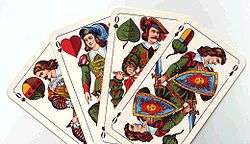German Schafkopf
 A picture of four Obers of German cards
| |
| Origin | Germany |
|---|---|
| Type | Point-trick game |
| Players | 4 |
| Cards | 32 |
| Deck | German or French |
| Play | Clockwise |
| Card rank (highest first) | (J) A K Q 10 9 8 7 |
| Related games | |
| Doppelkopf, Schafkopf, Sheepshead, Skat | |
German Schafkopf (German: Deutscher Schafkopf) is an old German card game and the forerunner of the popular modern games of Skat, Doppelkopf and Bavarian Schafkopf. Today it is hardly ever played in its original form, but there are a number of regional derivations.
Cards and trumps
Players and cards
German Schafkopf is played with 4 players and 32 cards which, depending on the region, may be German or French decks. The players form 2 teams that stay together for the evening.[1]
| Colours of the French suited cards | |||
| Diamonds (Karo) | Hearts (Herz) | Spades (Pik) | Clubs (Kreuz) |
| Colours of the German suited cards | |||
| Bells (Schellen) | Hearts (Herz) | Leaves (Laub) | Acorns (Eichel) |
Card values
| French deck | German deck | |||
| Card | Symbol | Card | Symbol | Points |
| Ace | A | Deuce | A/ (without) | 11 |
| Ten | 10 | Ten | 10 | 10 |
| King | K | King | K | 4 |
| Queen | D | Ober | O | 3 |
| Jack | B | Unter | U | 2 |
| Nine | 9 | Nine | 9 | 0 |
| Eight | 8 | Eight | 8 | 0 |
| Seven | 7 | Seven | 7 | 0 |
Card precedence
The precedence of the cards within the individual suits is as follows (highest to lowest): Ace (Deuce) > King > Queen (Ober) > 10 > 9 > 8 > 7
The hierarchy of the cards and their sequence within the trumps are similar to those in Bavarian Schafkopf and Skat. That said, in German Schafkopf the 10 ranks between the Queen or Ober and 9, both in the trump suit and in the remaining suits even though it is worth ten points.
Trumps
| German deck | |||
| Permanent trumps | |||
| Additional variable trump suits | |||
| Acorns | Leaves | Hearts | Bells |
| French deck | |||
| Permanent trumps | |||
| Additional variable trump suits | |||
| Clubs | Spades | Hearts | Diamonds |
As in Skat, the highest trumps are the 4 Jacks or Unters in the sequence Clubs, Spades, Hearts and Diamonds or Acorns, Leaves, Hearts and Bells. The remaining trumps are specified by the player who is the declarer by naming the trump suit at the outset. The cards of the trump suit then follow in the aforementioned sequence (see above).
Card partners
German Schafkopf is a partnering card game, but unlike Bavarian Schafkopf or Doppelkopf partners are not announced during the course of the game, but are agreed at the beginning as in Bridge: the players facing one another are automatically partners. The seating order is determined by the drawing of playing cards before the game begins: the players who have picked the two highest cards are partners and sit opposite one another. In another variation, the players with the two black queens (or Ober of Acorns and Ober of Leaves) form a partnership (see below).
Playing
Dealing
After the cards have been shuffled and cut, each player is dealt a total of eight playing cards (in two sets of four) in clockwise fashion.
Declaring in partner games
Then follows the declaring, which is also done in clockwise order. Each player announces the maximum possible number of trumps he can attain by adding the jacks and the longest suit in his hand ("I declare x trumps").
The player with the highest number of possible trumps takes the lead in the game and is allowed to choose the trump suit.
If two players announce the same number of possible trumps, then the one with the higher number of trump points wins ("I declare x trumps with y points"); if this number is also the same, the higher trump wins (usually the higher jack).
Additional rules
Players must follow suit. Only if a player does not hold the same suit in his hand can he either play a trump card or discard a card of another suit. Even trump cards must always be followed by a trump card. There is no compulsion to trick-taking in German Schafkopf.
Forced game
If none of the players can declare at least five trumps, the player with the Jack of Clubs (Unter of Acorns) must take the lead; if he loses, it only counts as single (i.e. he doesn't lose double or quadruple) game points.
Solo games
As in Bavarian Schafkopf and Doppelkopf, solo games are also possible in German Schafkopf. Here, a solo player plays against the other three players.
Scoring

For each game point won, the winner draws a line on a sheet of paper. The game is won by the first player to complete draw nine dashes in the shape of a sheep's head, the Schafkopf: four dashes arranged in a rectangle form the shape of the head, two dashes form the eyes, two more the horns and a single dash in the middle represents the nose.
There are three levels of win:
- Straight win (61 to 89 points scored): if the winner chose trumps he gets one game point, otherwise he gets two
- Schneider win (more than 90 points scored): if the winner chose trumps he gets two game points, otherwise four
- Schwarz win (opponents have no tricks): the winner gets nine game points, regardless of who chose trumps (nine dashes correspond to a whole sheep's head).
In a forced game, however, a winner who did not choose trumps gets the same as one who did.
Variations
The game described is only one form of German Schafkopf; as in Bavarian Schafkopf there are or were a plethora of variations about which little has been written.
A development of German Schafkopf is, for example, Bauernstoß, which is played in the Palatine region of Erfweiler.[2]
In an East German book of game rules there are the following variations of German Schafkopf:
- Classic Schafkopf: as described, Jacks/Wenzel are always trumps, the player with the so-called 'old man', the Jack of Clubs or the Unter of Acorns, must choose trumps if all pass or cannot bid more than 5 trumps.
- Schafkopf with six (eight) Wenzeln and changing trumps: Queen of Clubs (Ober of Acorns) and Queen of Spades (Ober of Leaves) (and Queen of Hearts (Ober of Hearts) and Queen of Diamonds (Ober of Bells)) are declared as trumps and outrank the old man. The player with the old man calls trumps, if this has not been decided beforehand by the bidding process.
- Schafkopf with four (six, eight) Wenzels and remaining trumps: Jacks/Wenzel (plus the 2 highest Queens/Obers or all 4) and Diamonds/Bells are always trumps.
References
- ↑ Grupp, Claus D. Doppelkopf Schafkopf. Niedernhausen: Falken (1994), p. 41. ISBN 3 8068 2015 5.
- ↑ "Bauernstoss" - ein unterhaltsames Kartenspiel aus Erfweiler/ Pfalz
Literature
- Rita Danyliuk: 1 × 1 der Kartenspiele - Bridge, Skat und Schafkopf. Glücks- und Familienspiele. Patiencen, Kartentricks u.v.m. Humboldt, Baden-Baden, 2008, ISBN 978-3-89994-188-3
- Rita Danyliuk: Das große Taschenbuch der Freizeitspiele: Spiele für unterwegs und Schönwettertage, Munich: Humboldt (1983), pp. 149-151.
- Claus D. Grupp: Doppelkopf - Schafkopf - Tarock. Original edition. Falken, Niedernhausen/ Ts., 1997, ISBN 3-635-60223-X
- Spielregelbüchlein mit Skatordnung. p. 177, 5th edn., Spielkartenfabrik Altenburg.